Several keyboard elaborations, or ‘intabulations’, of Byrd’s vocal works survive but this is the only arrangement thought to have been made by composer himself. It is also the only one based on one of his motets,
O quam gloriosum est regnum tuum, published in the 1589
Cantiones sacrae (but probably composed in about 1580). The texts used in the two sections had liturgical links with the Office texts for the Feast of All Saints, although Byrd’s publication of it was as a ‘sacred song,’ not as a work destined for the Catholic liturgy. The text of the first section is derived from the Magnificat antiphon ‘O how glorious is the kingdom wherein all the Saints rejoice with Christ! Clothed in white robes they follow the Lamb wherever he goes’, while that of the second section is derived from the service of None, ‘Blessing and glory and wisdom and thanksgiving and honour and power and might be unto our God for ever and ever, Amen’ (Revelation, Ch. 7, v. 12). Joseph Kerman reserves particularly appreciative words for the original 5-part vocal work: ‘The atmosphere gleams with lucid major triads’. He speaks of the ‘even, suffused light that informs O quam gloriosum’ and especially admires the way the piece ‘works its way effortlessly from word to word with the perfect, natural ‘framing’ that Byrd achieves when he is writing at the height of his inspiration’ (
Kerman, 1981, p 155).
The keyboard version survives without an attribution to Byrd in the only source. Alan Brown, writing in 1986, cautiously suggested that it might be ‘rash at this stage to attribute the arrangement to Byrd himself’ but Oliver Neighbour has since convincingly argued for his authorship: ‘It is the attempt to achieve greater clarity through changes in structural emphasis, especially in the highly imaginative treatment of the later sections, that is difficult to account for except as the work of the composer himself’ (Byrd Studies, 1992). Like many such intabulations of vocal pieces, the figuration added to the keyboard setting seems to impose a slower tempo than the sung original.
from notes by Davitt Moroney © 1999
Les manuscrits de l’époque contiennent plusieurs arrangements pour clavier d’œuvres vocales de Byrd mais cet arrangement est le seul considéré comme provenant du compositeur lui-même. C’est aussi l’unique arrangement de l’un de ses motets, en l’occurence
O quam gloriosum est regnum tuum, publié dans les
Cantiones sacrae de 1589 (mais sans doute composé vers 1580). Le texte avait un lien avec l’office de la fête de Toussaint, mais Byrd l’a publié comme une “chanson sacrée” et non pas à une fin liturgique. Le texte de la première partie est tiré de l’antienne pour le
Magnificat “O combien est glorieux le royaume où les saints se réjouissent avec le Christ ! Habillés en vêtements blancs, ils suivent l’Agneau partout où il va.” La seconde partie est également tirée de l’office : “Que la bénédiction, la gloire, la sagesse, les louanges, l’honneur, le pouvoir et la force soient avec notre Dieu jusqu’à la fin des temps, Amen” (Apocalypse, Ch. 7, v. 12). Joseph Kerman réserve à la version originale, pour cinq voix, un commentaire particulièrement perspicace. “L’atmosphère brille d’accords majeurs lumineux”, dit-il, en évoquant “la luminosité sereine qui se répand sur O quam gloriosum”. Il admire surtout “la perfection du cheminement progressif de mot en mot, de phrase en phrase, par la mise en musique naturellement ‘conçue d’après la vie des paroles’, perfection à laquelle Byrd réussit quand il est au sommet de son inspiration” (
Kerman, 1981, p. 155).
Cette version pour clavier n’est pas attribuée à Byrd dans l’unique source. Alan Brown, en 1986, avait suggéré avec précaution qu’il serait peut-être “téméraire pour l’instant de l’attribuer à Byrd lui-même”, mais Oliver Neighbour a depuis présenté des arguments solides en faveur du compositeur : “C’est la tentative d’établir une plus grande clarté par des changements structurals, et surtout le traitement très imaginatif de la dernière partie, qui rendent difficile l’attribution à quelqu’un d’autre” (Byrd Studies, 1992). A l’instar de beaucoup de transcriptions, l’ornementation ajoutée semble imposer à la version pour clavier un tempo plus lent que pour la version chantée.
extrait des notes rédigées par Davitt Moroney © 1999


 Byrd: The Complete Keyboard Music
Byrd: The Complete Keyboard Music
